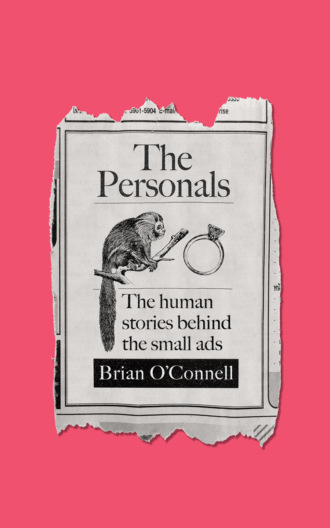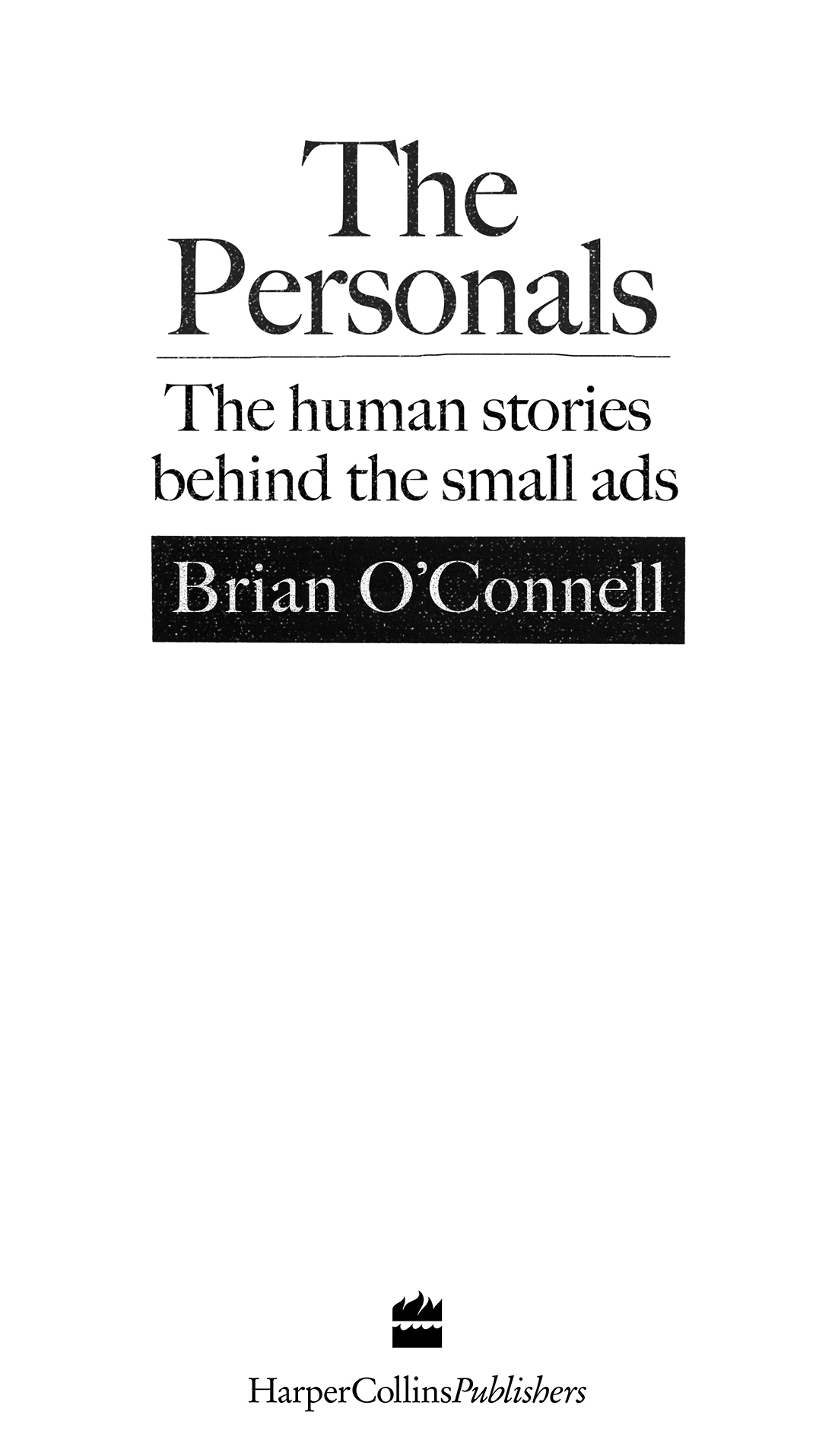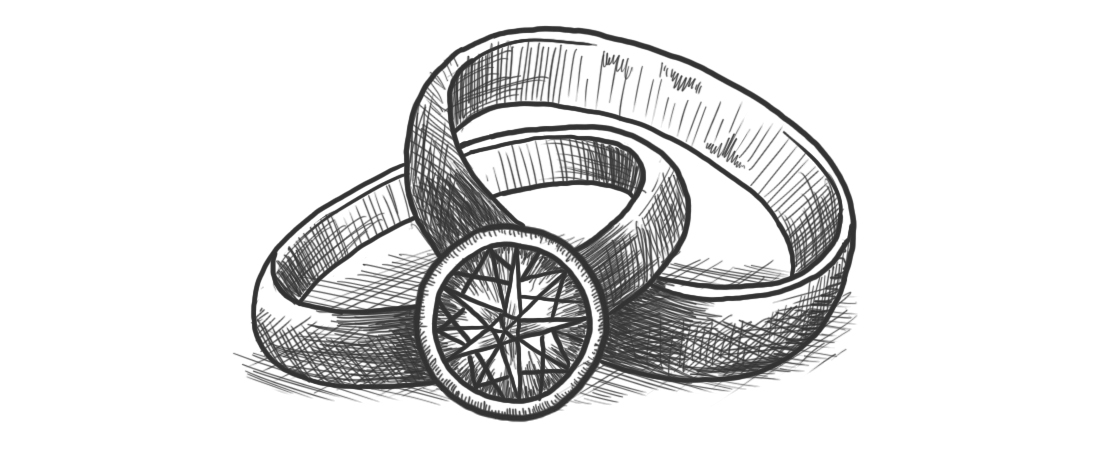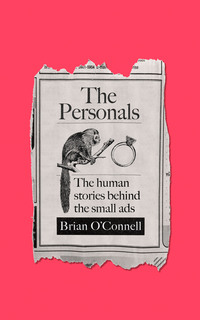
Полная версия
The Personals


Copyright
In order to protect privacy, some names, identifying characteristics, dialogue and details have been changed or reconstructed.
HarperCollinsPublishers
1 London Bridge Street
London SE1 9GF
www.harpercollins.co.uk
First published by HarperCollinsPublishers 2019
FIRST EDITION
© Brian O’Connell 2019
Illustrations © Micaela Alcaino 2019
Cover layout design © HarperCollinsPublishers 2019
Cover images © shutterstock.com
A catalogue record of this book is available from the British Library
Brian O’Connell asserts the moral right to be identified as the author of this work
All rights reserved under International and Pan-American Copyright Conventions. By payment of the required fees, you have been granted the nonexclusive, non-transferable right to access and read the text of this e-book on screen. No part of this text may be reproduced, transmitted, downloaded, decompiled, reverse engineered, or stored in or introduced into any information storage retrieval system, in any form or by any means, whether electronic or mechanical, now known or hereinafter invented, without the express written permission of HarperCollins e-books.
Find out about HarperCollins and the environment at
www.harpercollins.co.uk/green
Source ISBN: 9780008321345
Ebook Edition © October 2019 ISBN: 9780008321352
Version: 2019-09-06
Note to Readers
This ebook contains the following accessibility features which, if supported by your device, can be accessed via your ereader/accessibility settings:
Change of font size and line height
Change of background and font colours
Change of font
Change justification
Text to speech
Page numbers taken from the following print edition: ISBN 9780008321345
Dedication
‘Just for a second, I thought I lost myself,
And I watched my body falling,
And all the colours look brighter now.’
Brian Carey, RIP
Contents
1 Cover
2 Title Page
3 Copyright
4 Note to Readers
5 Dedication
6 Contents
7 Introduction
8 PART ONE: LOVE AND LOSS
9 When East Meets West
10 A Ringless Marriage
11 A Dress for the (Middle) Ages
12 A Chance Encounter of a Shocking Kind
13 A Long Engagement
14 Addicted to Love?
15 A Marriage Worth Waiting For
16 PART TWO: EQUIPPED FOR LIFE
17 The Car That’s Bulletproof
18 For Your Eyes Only
19 Running Up That Hill
20 PART THREE: PETS’ CORNER
21 A Monkey Is for Life – Not Just for Christmas
22 Finding Shangri-La
23 Making It Pig in Hollywood
24 PART FOUR: ARTICLES OF WAR
25 Married to the Past
26 ‘Grow Wheat – The Crop That Pays’
27 Zen and the Art of Phone Box Maintenance
28 Engineering a Step Back in Time
29 The Weight of History
30 PART FIVE: SENTIMENTAL VALUE
31 Rekindling a One in a Million Chance
32 Remains of a Detached Day
33 Giving a Doll’s House a Home
34 PART SIX: COLLECTORS
35 ‘We Are Collectors ... and We Will Die as Collectors’
36 Signing the Past Away
37 PART SEVEN: LOST CAUSES?
38 Being Frank
39 Building a Bigger Shrine
40 PART EIGHT: THIS MORTAL COIL
41 Meeting a Man About a Hearse
42 Plotting a Way Out of Grief
43 PART NINE: SIGNS OF THE TIMES
44 Nursing Hidden Desires
45 Cut-Price Counselling
46 The Homeless Hotel
47 Making Study Pay
48 Acknowledgements
49 About the Publisher
LandmarksCoverFrontmatterStart of ContentBackmatter
List of Pagesiiiivv1234567891112131415161718192021222324252627282930313233343536373839404142434445464748495051525354555657585960616263646567686970717273747576777879808182838485868789919293949596979899100101102103104105106107108109111113114115116117118119120121122123124125126127128129130131132133134135136137138139140141142143144145146147148149150151153154155156157158159160161162163164165166167168169170171172173175176177178179180181182183184185186187188189190191192193195196197198199200201202203204205207209210211212213214215216217218219220221222223224225226227228229231232233234235236237238239240241242243244245246247248249250251252253254255256257258259260261262263264265266267268269270271272273274275276277
Introduction
The story goes that Ernest Hemingway and a few of his literary pals were knocking about the Algonquin Hotel in New York one night in the 1920s, before they had the joys of social media to help them avoid conversation, and they began challenging each other to write a novel using just six words. Cutting a long story short, Hemingway is said to have won hands down with the words: ‘For Sale: Baby Shoes, Never Worn.’
He’s reputed to have said that those six words were the best he ever wrote. They are loaded with life experience, love, loss, death and hope perhaps; a six-word portal into lived experience that Dorothy Parker or William Carlos Williams might have been proud of. The only problem is, while this sounds a plausible story that has been handed down over decades as literary fact, it probably never happened – or if it did happen, it almost certainly predated Hemingway and his bohemian clique. An essay about a similar short story by William R. Kane appeared in 1917 and a newspaper column by R. K. Moulton in 1921 pointed to an advert he had seen: ‘Baby Carriage for Sale: Never Used’ and informed his readers that it embodied the plot of a story. The Hemingway anecdote probably evolved over time, as a literary agent more or less admitted decades later when he said that he had first heard the story from a newspaper syndicator in the mid-1970s, more than a decade after Hemingway had died.
The point is that classified ads have long held fascination as a rich source of human experience and stories. When starting out in journalism in local media, I remember staring out of the window on a dreary Tuesday morning, stuck for story ideas for that morning’s pitching session. I shared my frustration with an older editor, who told me to try the small ads. So I did, and I have returned to them again and again in the two decades since as a source of stories.
In an era of PR handlers and press releases, of government advertising camouflaged as journalism, and carefully chosen interviewees who are sometimes over-coached and underwhelming, the world of classified ads, both online and in print, offers an unfiltered window into society.
I’ve spent almost two decades in journalism, and something interesting has happened in that time. People have never put as much of themselves out there as they do today, whether through social or digital media, or by sharing their stories or ‘opening up’ in more traditional media. There have never been so many filters or gatekeepers trying to shape those narratives. Sometimes an interviewee may have shared their story online, had a media training workshop, or may already possess a ‘them and us’ mentality about journalists and the media in general before I even get to speak to them. Some of that mistrust is warranted, and very healthy of course, but there’s also cynicism in a lot of encounters, and many more competing agendas than previously when I sit across from someone and press record.
When using Instagram, Snapchat, Facebook live, video and audio messaging we are all much more aware of how we project ourselves than ever before. As a result, people often display a caginess and deep self-awareness of how they conduct themselves during an interview. One contradiction I’ve come across is that the more people are willing to expose of their lives online, the less personal and intimate they may want to be in one-to-one encounters. Authenticity can become a casualty, chance encounters become less likely and conversations without agendas are at a premium.
Hopefully, because of all that, you can see why personal ads – and the people and lives and secrets and stories and heartbreak and quirkiness that sometimes lie behind them – are so appealing to this fortysomething and somewhat sentimental hack, and why I thought they would work well collected in a book. The ads allow me to move away from the managed world of spin doctors and carefully planned media campaigns to a less self-conscious world – one that I think is at times more authentic.
Of course, part of this book is about items for sale, but that section is also about the off-piste moments when an ad for a ring turns into a discussion about dementia, or a poster for sale reveals the struggles of independent shops in rural Ireland. These ads also show how letting go of an item becomes a lesson in how to own your grief, or how living with and then discarding addiction can paradoxically set you free. Classified ads brought me into people’s lives for no other reason than the fact that they let me in. There were no PR agencies, no communication strategies, no media advisers and no campaigns wrapped tightly around case studies. As they say on Judge Judy, the stories are real, the people are real!
On a basic level, I’m also drawn to these ads because they throw up some humdingers of stories. The excitement for me, and I hope for you reading this, is going from a few lines of text to the trenches of the First World War, or getting an insight into the complexities of a relationship break-up, or the obsessive mind of a fixated collector – or simply capturing a time or a story or an experience that would otherwise not be documented.
When I was about halfway through researching this book, my wife peered into my office and saw me sitting with my feet on the desk, steaming cup of tea in hand, scrolling through a list of ‘never worn’ wedding dresses for sale. The slightly worrying thing is that she didn’t bat an eyelid. My obsession with classified ads is really an obsession with people’s lives and stories – the ads are just a doorway through which I stick my head.
There was a time not long ago when I sourced most of these stories solely from ads in print media – places such as the Irish Farmer’s Journal, Ireland’s Own, The Echo and many broadsheets had extensive classified sections, as well as personal pages. The majority of these ads have migrated online, as sites such as Craigslist and later Adverts, Gumtree and DoneDeal made it much easier to buy and sell in the digital era. And so I have followed suit.
By collating a selection of recent adverts and some I have captured over the last few years, I want to take you down lanes and into homes, into hearts and cluttered minds and tell stories that would not otherwise be told. In all except maybe half a dozen of these stories, I have met the people behind the ads in person, usually travelling to their homes or meeting them in a car or cafe nearby. When that wasn’t possible, or the poster did not want to meet, we spoke at length on the phone or through email.
What draws me into these ads are the personal stories – the reasons for a break-up, how a child collector became an adult one or why someone feels the need to sell a treasured ring that has come to represent something tainted or tragic.
Through the years there have been some important ads that have signalled significant societal change. These were the ads in the early part of the twentieth century looking for ‘good Catholic homes’ for the children of ‘fallen women’ for example, or the aged bachelor farmers looking for girls in their late teens to become ‘life partners’, or those looking for domestic servants, or the emigrants in Australia trying to reconnect with family many decades later. You could write a whole social history on the classified ads of past decades.
Two books worth reading on this are Strange Red Cow, Sarah Bader’s fascinating trawl through the vintage classified ads of US publications, and Classified by H. G. Cocks, an interesting take on how sexuality and society evolved in Britain, again through the prism of the small ads. In his book, Cocks traces the rise of personal ads to respectability, from one of the first ecclesiastical style ads in the fifteenth century through the invention of modern newspapers in the mid-seventeenth century right up to today. One of his central points is that the internet today ‘merely accelerates processes which, when people had to rely on print and the postal service, just took longer to achieve.’ Cocks makes a compelling argument that the small ad was a ‘symbol of everything that was both exciting and dangerous about modern sexuality’ and that the classifieds have been a gateway to all sorts of delights and dangers ever since their invention, showing how ordinary people grappled with love, sex, marriage, friendship and commerce through recent centuries.
All the stories in this book are quite recent and attempt to document snapshots of life in Ireland today. There are also stories and ads which I hope bring history to life – such as the military medals and memorabilia for sale, the nineteenth-century hearse, the impact of mother and baby homes or the frayed match programme for a long forgotten All-Ireland final.
I’ve divided the book into parts and the timeline roughly spans the period from 2012 to the present. In several of the stories, you’ll notice that I haven’t given the name of the person posting the ad and don’t identify where they’re located, or I’ve used a pseudonym. This is at their request and I was happy to proceed on the basis that no one was identified, especially with some of the more sensitive ads. I don’t think this detracts from the account of their experiences.
The way I sourced the material was simple. Most weeks I scoured the small ads in places such as the Evening Echo (since renamed The Echo) or online on DoneDeal. I was looking for hints that there was a story or a life experience worth hearing hidden behind the few lines of text on page or screen.
When I thought an ad had potential I would text the poster, explain that I was interested in the story behind it and ask whether they would take a call. Some thought I was part of an elaborate scam to fiddle them out of their item for sale, while others, particularly those recently bereaved, were very happy to sit and talk about their life experiences.
I’m very grateful to everyone who shared their stories and let me into their homes, or met me in hotels, cafes or parked cars, or took a phone call and spilled their heart out and shared with me intimate details of their life. There was really nothing in it for them; by the time this book is published most of their ads will have long since expired, so it was hugely refreshing to be able to talk to people simply because they wanted to share some of their story with me.
While the ad is a signpost, it’s ultimately the people who drew me in, and the adage that everyone has a story. The privilege for me is in contacting a stranger and shortly afterwards sharing some of the more intimate moments of their life, with no agenda or preconditions. Throughout this process the joy was in finding unexpected twists and turns, lessons learned and the life experiences gained, all trapped iceberg-like beneath a few lines of classified text on a page or screen. Those kinds of discoveries are what brought me back again and again to these stories.
Some people do Sudoku, others binge on box sets; I trawl the classified ads ...
Part One
LOVE AND LOSS

When East Meets West
Beautiful wedding and engagement ring for sale. €3,000 or nearest offer. DoneDeal, June 2018
Weeds are growing up through the barriers at the edge of the estate I’m driving through, as Google Maps and I have one of our many disagreements and I circle round at least half a dozen times.
The gravel-filled fields beyond those barriers were once called ‘Phase 2’ on a glossy Celtic Tiger era brochure, probably launched in a penthouse with a rugby player and canapés. Now the scabby site adjacent remains a stubborn scar on the landscape, a reminder that we lost control and that this estate was over-hyped and over-extended until the building came to an abrupt end.
I’m in one of the attractive, three-bedroomed, semi-detached houses which could easily have been the show house. Large candles are lit around the fireplace and there’s one of those evocative black and white coastal prints on the wall. Despite the welcome, it has been made clear to me that I will have to grant anonymity to the seller, because the events which led to the rings being put up for sale were relatively recent and raw. Apart from that precondition, she really wanted to tell her story and had seemed warm and friendly on the phone.
She is a fortysomething woman, and in her sitting room there are clues that she is well travelled – an African mask here, an Asian figurine there. I’m not sure that it’s a house that has seen many four a.m. Christy Moore singalongs; everything seems particularly placed, and because we meet just as she’s come in from work, I assume that the house always looks this gleaming and wasn’t scrubbed for my sake. I also guess that no small children live here – the lighted candles and open bowls of potpourri give this away.
We take a seat on the couch and I can see she’s a little nervous, but also quite open, and in her hand, she flips the lid of a ring box open and closed while we make small talk and I compliment her on the interior. I watch as each flick open reveals glistening stones, while each movement shut smothers the sparkly diamonds in darkness. She tells me that her rings have been in this box since last year and pauses, presumably waiting for me to ask what happened. I hold off as I often do in these encounters. Sometimes the longer you hold off talking about the elephant in the room the louder the elephant will demand to be heard. Also, we’re having tea and the biscuits are really nice.
By way of easing into the story, I ask her to describe the rings to me, which saves me the embarrassment of discussing something I know zilch about. ‘The engagement ring is a solitaire ring and it has encrusted diamonds halfway on each shoulder,’ she explains, thinking about, and then resisting the urge, to put it on her finger. ‘The wedding ring would have the same type of encrusted diamonds. So, this is a band of diamonds and they have the same set on the side. They are stunning rings. I think in total it’s one carat. I initially picked the diamonds and I got them in Dubai and the company that were making them for me called me up to say they had sourced a nicer-quality diamond, and they were looking for permission to put it in. So, it was crafted with great care and consideration and there’s no inscription on them.’
The rings, the box, the inlay cards and the lack of inscription all make it look as if they’ve just come off the shelf from a high-street jeweller. Have they ever actually been on her finger, I ask? ‘Yes, they went on my finger in December 2015 and they came off in September 2017. So just under two years. Do you want to know the story?’
As we continued to chat over tea and Club Milks, it became clear that while parts of this story were about lost love (or perhaps false love), another part was about the pressure to conform. More accurately, it’s about the social anxiety that builds when you get to your late thirties, see your friends marry and partner up one by one, and feel that part of society has its sights fixed on you and that some judge you by your singleness. In reality of course, those who have partnered up and are dealing with early morning Peppa Pig breakfasts are probably so preoccupied with lack of sleep and reducing their mortgage repayments that they barely notice anything except their expanding midriffs and greying hairs.

That insight into single life will come later; for now I ask my host if she would like to tell me how she fell in love. ‘Well, I married a non-EU national, someone from the Middle East, in Lebanon in December 2015,’ she explains, in a voice that’s not so much bitter as rueful. ‘We had known each other a year and a half at that stage. What attracted me to him was his drive and his commitment to working with young people. I share the same values. He proposed to me and of course I said yes to this handsome man.’
And for the first time the nerves are gone and she’s smiling as she recounts their early courtship. Had she any hesitation at the time, I ask? ‘In my naivety, no,’ she says. ‘I had considered motivations briefly; why he would ask someone to marry so quickly, but I would have thought maybe he loved me. I didn’t really question that. I should have.’
After they married, she returned home in late 2015, and after Christmas that year applied for his spousal visa so he could come to Ireland. This application turned into a lengthy and intrusive process during which their relationship needed to be verified, requiring testimony from family and friends that it was a legitimate marriage.
All her family were happy to give their testimony, and all were convinced this relationship was for real. In total, the process cost €4,000. This should have been the starting point for a wonderful life together in Ireland. Instead, it became the point at which their short marriage came unstuck and she felt the gaze of partnered society even more acutely. ‘His visa was refused in August 2017,’ she says. ‘And the day after I told him it had been refused, he told me he was marrying someone else. Just like that.’
Her voice fills with emotion as she tells me this, as when someone recalls a recent bereavement. Two weeks after that phone call she was devastated when it was confirmed that her husband had in fact married someone else. While their relationship had been long distance, he had been to Ireland for a visit, and she had been to his country several times, and they spoke on the phone every day. But a fortnight after she had told him of the visa refusal, her husband’s new wife sent her a screenshot of their marriage certificate. Talk about moving on quickly ...
It’s a difficult question, but I ask her whether she thinks his second marriage was prompted by the visa refusal. After a long pause, she looks at me with reddening eyes and says: ‘Yeah. I think it was just a matter of what will he do next to make life comfortable for himself? I think he was able to draw a line under it very quickly and move on to his next plan. He denied it for a while. His family confirmed he had got married again, and for a while I was bargaining with him, saying, “It is OK; you can remain married to her and remain married to me as well,” – he can have four wives after all, because of his culture.’





